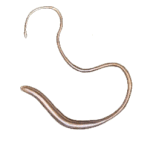Whipworms live in the large intestine of dogs and irritate the lining causing watery, bloody diarrhoea and weight loss.
Whipworms produce microscopic eggs that pass out in the dog’s faeces. The eggs resist drying and heat, and can infect another dog years later. Dogs housed on dirt or grass that is not regularly cleaned of faeces risk whipworm infestation.
 Whipworm eggs in the faeces confirm a whipworm infestation. However, they are often hard to find as the worms only produce small numbers of eggs on an irregular basis. Any dog with chronic diarrhoea could have whipworms despite negative faecal examinations. Response to treatment indicates that whipworms were present after all.
Whipworm eggs in the faeces confirm a whipworm infestation. However, they are often hard to find as the worms only produce small numbers of eggs on an irregular basis. Any dog with chronic diarrhoea could have whipworms despite negative faecal examinations. Response to treatment indicates that whipworms were present after all.
Most broad spectrum wormers, including Milbemax and Drontal are effective against whipworms.
Whipworms are not infectious to people. They are only parasites of the dog.


